The Impact of Price Wars: Coles vs. Woolworths in Australian Market
VerifiedAdded on 2020/03/04
|7
|1338
|60
Report
AI Summary
This report provides an economic analysis of the price war between Coles and Woolworths, the two major supermarkets in Australia. It examines the market structure, which is identified as a competitive oligopoly, and explores the impact of their price competition on consumers, suppliers, and the overall market. The report discusses the role of advertising, barriers to entry, and the inefficiencies present in the sector. It highlights the competitive strategies employed by Coles and Woolworths to maintain or increase their market share, including price cuts and promotional activities. Furthermore, the report evaluates the advantages and weaknesses of the industry, recommending improvements through better information dissemination by the competition commission and government monitoring to prevent collusion. The analysis draws on data from 2017, providing a snapshot of the competitive environment at that time.
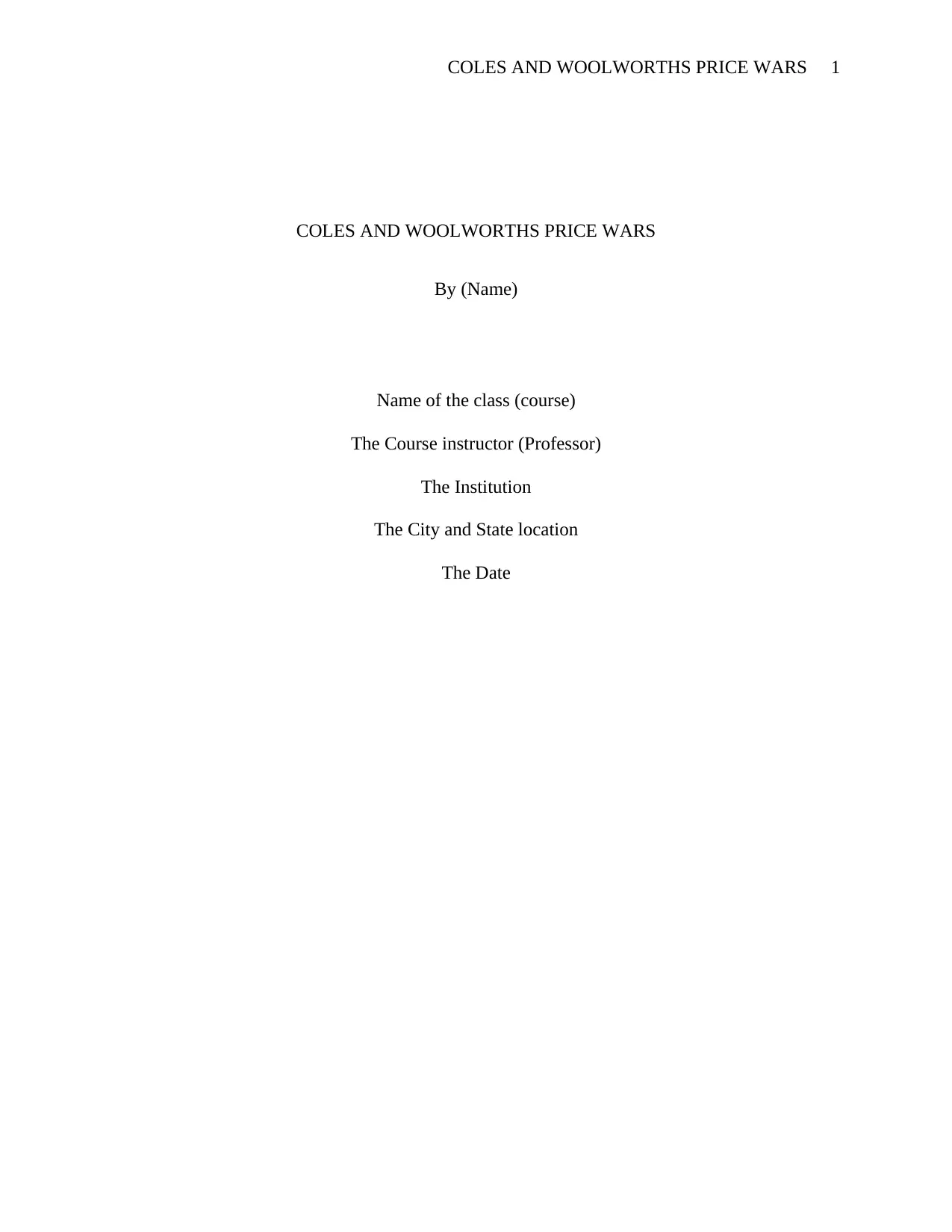
COLES AND WOOLWORTHS PRICE WARS 1
COLES AND WOOLWORTHS PRICE WARS
By (Name)
Name of the class (course)
The Course instructor (Professor)
The Institution
The City and State location
The Date
COLES AND WOOLWORTHS PRICE WARS
By (Name)
Name of the class (course)
The Course instructor (Professor)
The Institution
The City and State location
The Date
Paraphrase This Document
Need a fresh take? Get an instant paraphrase of this document with our AI Paraphraser
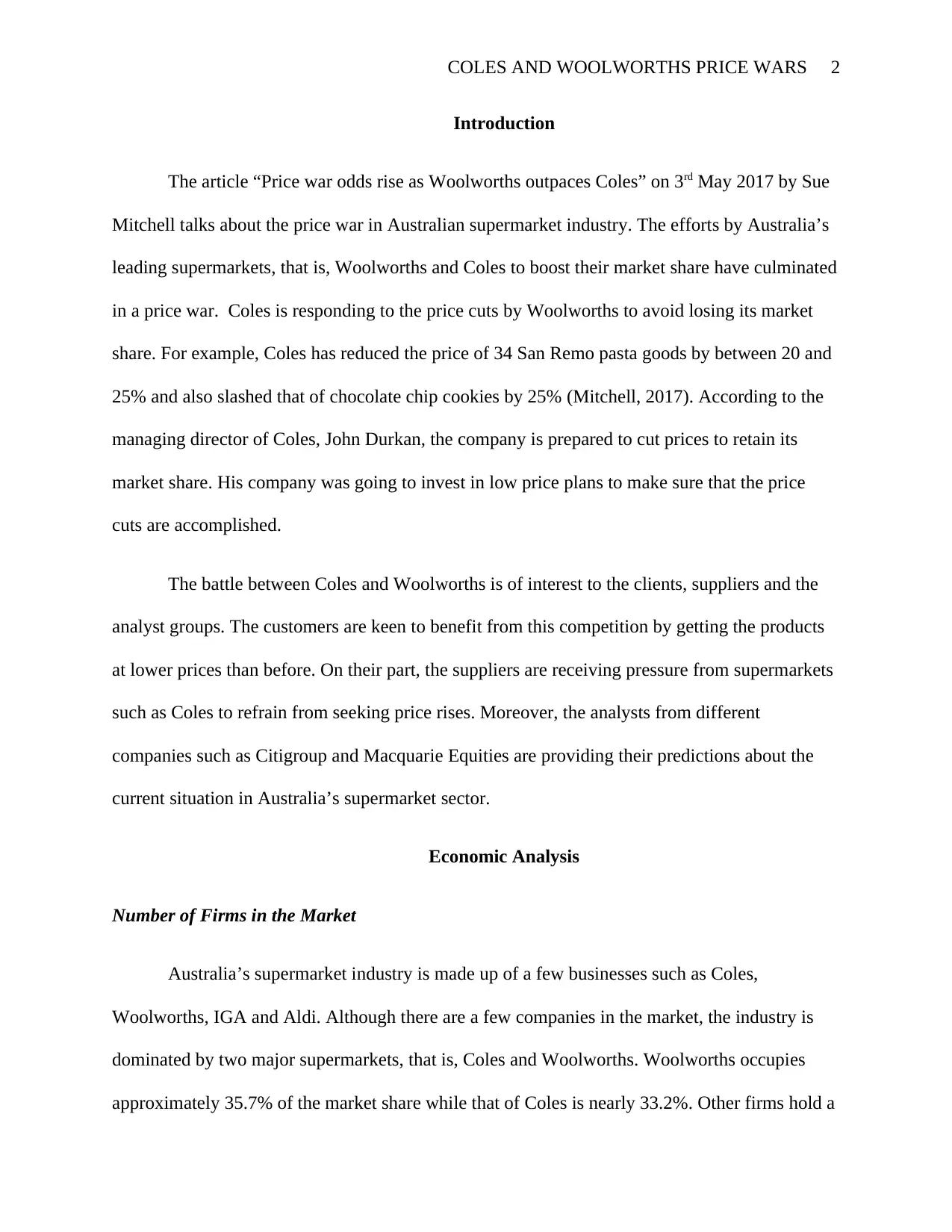
COLES AND WOOLWORTHS PRICE WARS 2
Introduction
The article “Price war odds rise as Woolworths outpaces Coles” on 3rd May 2017 by Sue
Mitchell talks about the price war in Australian supermarket industry. The efforts by Australia’s
leading supermarkets, that is, Woolworths and Coles to boost their market share have culminated
in a price war. Coles is responding to the price cuts by Woolworths to avoid losing its market
share. For example, Coles has reduced the price of 34 San Remo pasta goods by between 20 and
25% and also slashed that of chocolate chip cookies by 25% (Mitchell, 2017). According to the
managing director of Coles, John Durkan, the company is prepared to cut prices to retain its
market share. His company was going to invest in low price plans to make sure that the price
cuts are accomplished.
The battle between Coles and Woolworths is of interest to the clients, suppliers and the
analyst groups. The customers are keen to benefit from this competition by getting the products
at lower prices than before. On their part, the suppliers are receiving pressure from supermarkets
such as Coles to refrain from seeking price rises. Moreover, the analysts from different
companies such as Citigroup and Macquarie Equities are providing their predictions about the
current situation in Australia’s supermarket sector.
Economic Analysis
Number of Firms in the Market
Australia’s supermarket industry is made up of a few businesses such as Coles,
Woolworths, IGA and Aldi. Although there are a few companies in the market, the industry is
dominated by two major supermarkets, that is, Coles and Woolworths. Woolworths occupies
approximately 35.7% of the market share while that of Coles is nearly 33.2%. Other firms hold a
Introduction
The article “Price war odds rise as Woolworths outpaces Coles” on 3rd May 2017 by Sue
Mitchell talks about the price war in Australian supermarket industry. The efforts by Australia’s
leading supermarkets, that is, Woolworths and Coles to boost their market share have culminated
in a price war. Coles is responding to the price cuts by Woolworths to avoid losing its market
share. For example, Coles has reduced the price of 34 San Remo pasta goods by between 20 and
25% and also slashed that of chocolate chip cookies by 25% (Mitchell, 2017). According to the
managing director of Coles, John Durkan, the company is prepared to cut prices to retain its
market share. His company was going to invest in low price plans to make sure that the price
cuts are accomplished.
The battle between Coles and Woolworths is of interest to the clients, suppliers and the
analyst groups. The customers are keen to benefit from this competition by getting the products
at lower prices than before. On their part, the suppliers are receiving pressure from supermarkets
such as Coles to refrain from seeking price rises. Moreover, the analysts from different
companies such as Citigroup and Macquarie Equities are providing their predictions about the
current situation in Australia’s supermarket sector.
Economic Analysis
Number of Firms in the Market
Australia’s supermarket industry is made up of a few businesses such as Coles,
Woolworths, IGA and Aldi. Although there are a few companies in the market, the industry is
dominated by two major supermarkets, that is, Coles and Woolworths. Woolworths occupies
approximately 35.7% of the market share while that of Coles is nearly 33.2%. Other firms hold a
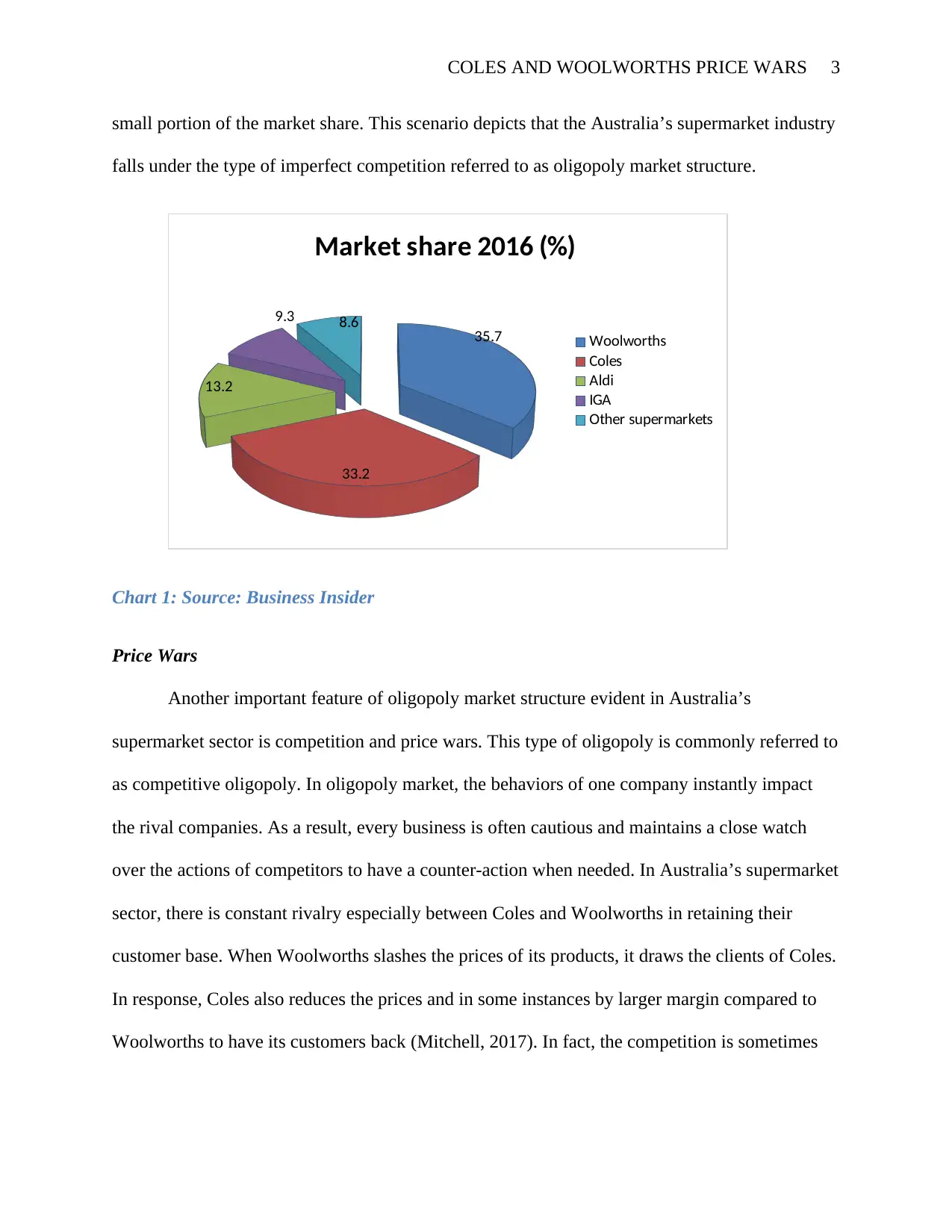
COLES AND WOOLWORTHS PRICE WARS 3
small portion of the market share. This scenario depicts that the Australia’s supermarket industry
falls under the type of imperfect competition referred to as oligopoly market structure.
35.7
33.2
13.2
9.3 8.6
Market share 2016 (%)
Woolworths
Coles
Aldi
IGA
Other supermarkets
Chart 1: Source: Business Insider
Price Wars
Another important feature of oligopoly market structure evident in Australia’s
supermarket sector is competition and price wars. This type of oligopoly is commonly referred to
as competitive oligopoly. In oligopoly market, the behaviors of one company instantly impact
the rival companies. As a result, every business is often cautious and maintains a close watch
over the actions of competitors to have a counter-action when needed. In Australia’s supermarket
sector, there is constant rivalry especially between Coles and Woolworths in retaining their
customer base. When Woolworths slashes the prices of its products, it draws the clients of Coles.
In response, Coles also reduces the prices and in some instances by larger margin compared to
Woolworths to have its customers back (Mitchell, 2017). In fact, the competition is sometimes
small portion of the market share. This scenario depicts that the Australia’s supermarket industry
falls under the type of imperfect competition referred to as oligopoly market structure.
35.7
33.2
13.2
9.3 8.6
Market share 2016 (%)
Woolworths
Coles
Aldi
IGA
Other supermarkets
Chart 1: Source: Business Insider
Price Wars
Another important feature of oligopoly market structure evident in Australia’s
supermarket sector is competition and price wars. This type of oligopoly is commonly referred to
as competitive oligopoly. In oligopoly market, the behaviors of one company instantly impact
the rival companies. As a result, every business is often cautious and maintains a close watch
over the actions of competitors to have a counter-action when needed. In Australia’s supermarket
sector, there is constant rivalry especially between Coles and Woolworths in retaining their
customer base. When Woolworths slashes the prices of its products, it draws the clients of Coles.
In response, Coles also reduces the prices and in some instances by larger margin compared to
Woolworths to have its customers back (Mitchell, 2017). In fact, the competition is sometimes
⊘ This is a preview!⊘
Do you want full access?
Subscribe today to unlock all pages.

Trusted by 1+ million students worldwide
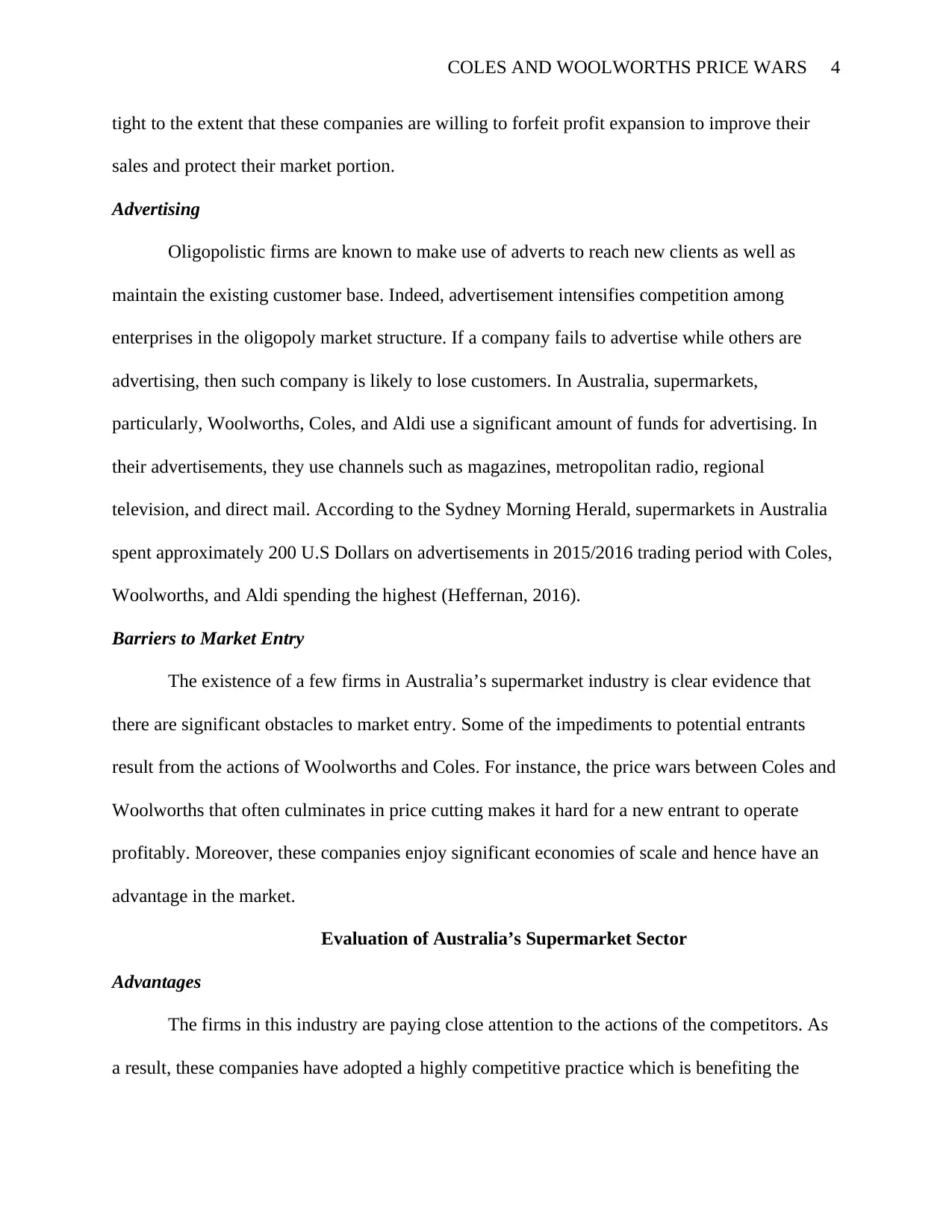
COLES AND WOOLWORTHS PRICE WARS 4
tight to the extent that these companies are willing to forfeit profit expansion to improve their
sales and protect their market portion.
Advertising
Oligopolistic firms are known to make use of adverts to reach new clients as well as
maintain the existing customer base. Indeed, advertisement intensifies competition among
enterprises in the oligopoly market structure. If a company fails to advertise while others are
advertising, then such company is likely to lose customers. In Australia, supermarkets,
particularly, Woolworths, Coles, and Aldi use a significant amount of funds for advertising. In
their advertisements, they use channels such as magazines, metropolitan radio, regional
television, and direct mail. According to the Sydney Morning Herald, supermarkets in Australia
spent approximately 200 U.S Dollars on advertisements in 2015/2016 trading period with Coles,
Woolworths, and Aldi spending the highest (Heffernan, 2016).
Barriers to Market Entry
The existence of a few firms in Australia’s supermarket industry is clear evidence that
there are significant obstacles to market entry. Some of the impediments to potential entrants
result from the actions of Woolworths and Coles. For instance, the price wars between Coles and
Woolworths that often culminates in price cutting makes it hard for a new entrant to operate
profitably. Moreover, these companies enjoy significant economies of scale and hence have an
advantage in the market.
Evaluation of Australia’s Supermarket Sector
Advantages
The firms in this industry are paying close attention to the actions of the competitors. As
a result, these companies have adopted a highly competitive practice which is benefiting the
tight to the extent that these companies are willing to forfeit profit expansion to improve their
sales and protect their market portion.
Advertising
Oligopolistic firms are known to make use of adverts to reach new clients as well as
maintain the existing customer base. Indeed, advertisement intensifies competition among
enterprises in the oligopoly market structure. If a company fails to advertise while others are
advertising, then such company is likely to lose customers. In Australia, supermarkets,
particularly, Woolworths, Coles, and Aldi use a significant amount of funds for advertising. In
their advertisements, they use channels such as magazines, metropolitan radio, regional
television, and direct mail. According to the Sydney Morning Herald, supermarkets in Australia
spent approximately 200 U.S Dollars on advertisements in 2015/2016 trading period with Coles,
Woolworths, and Aldi spending the highest (Heffernan, 2016).
Barriers to Market Entry
The existence of a few firms in Australia’s supermarket industry is clear evidence that
there are significant obstacles to market entry. Some of the impediments to potential entrants
result from the actions of Woolworths and Coles. For instance, the price wars between Coles and
Woolworths that often culminates in price cutting makes it hard for a new entrant to operate
profitably. Moreover, these companies enjoy significant economies of scale and hence have an
advantage in the market.
Evaluation of Australia’s Supermarket Sector
Advantages
The firms in this industry are paying close attention to the actions of the competitors. As
a result, these companies have adopted a highly competitive practice which is benefiting the
Paraphrase This Document
Need a fresh take? Get an instant paraphrase of this document with our AI Paraphraser
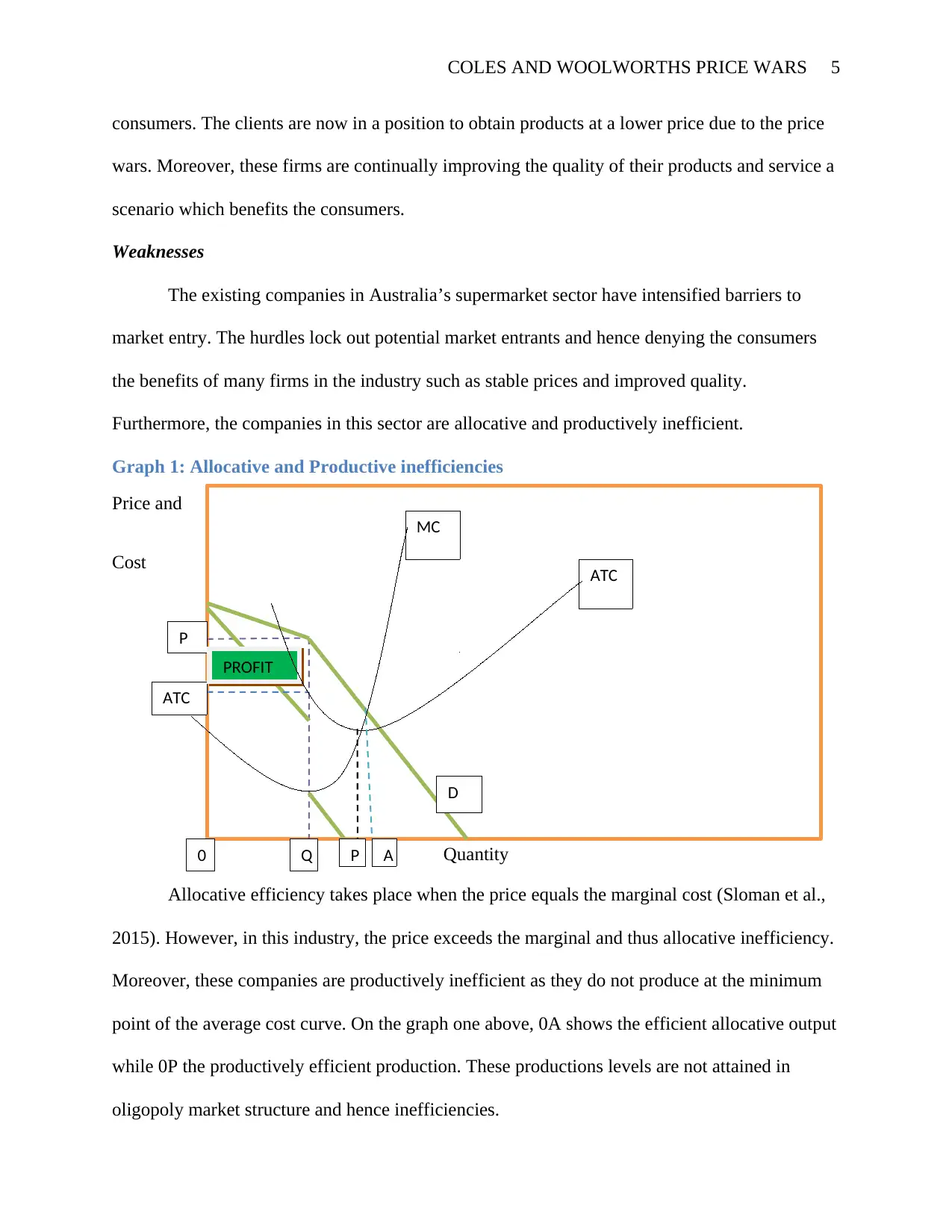
COLES AND WOOLWORTHS PRICE WARS 5
consumers. The clients are now in a position to obtain products at a lower price due to the price
wars. Moreover, these firms are continually improving the quality of their products and service a
scenario which benefits the consumers.
Weaknesses
The existing companies in Australia’s supermarket sector have intensified barriers to
market entry. The hurdles lock out potential market entrants and hence denying the consumers
the benefits of many firms in the industry such as stable prices and improved quality.
Furthermore, the companies in this sector are allocative and productively inefficient.
Graph 1: Allocative and Productive inefficiencies
Price and
Cost
Quantity
Allocative efficiency takes place when the price equals the marginal cost (Sloman et al.,
2015). However, in this industry, the price exceeds the marginal and thus allocative inefficiency.
Moreover, these companies are productively inefficient as they do not produce at the minimum
point of the average cost curve. On the graph one above, 0A shows the efficient allocative output
while 0P the productively efficient production. These productions levels are not attained in
oligopoly market structure and hence inefficiencies.
P
MC
ATC
Q
D
ATC
PROFIT
P A0
consumers. The clients are now in a position to obtain products at a lower price due to the price
wars. Moreover, these firms are continually improving the quality of their products and service a
scenario which benefits the consumers.
Weaknesses
The existing companies in Australia’s supermarket sector have intensified barriers to
market entry. The hurdles lock out potential market entrants and hence denying the consumers
the benefits of many firms in the industry such as stable prices and improved quality.
Furthermore, the companies in this sector are allocative and productively inefficient.
Graph 1: Allocative and Productive inefficiencies
Price and
Cost
Quantity
Allocative efficiency takes place when the price equals the marginal cost (Sloman et al.,
2015). However, in this industry, the price exceeds the marginal and thus allocative inefficiency.
Moreover, these companies are productively inefficient as they do not produce at the minimum
point of the average cost curve. On the graph one above, 0A shows the efficient allocative output
while 0P the productively efficient production. These productions levels are not attained in
oligopoly market structure and hence inefficiencies.
P
MC
ATC
Q
D
ATC
PROFIT
P A0
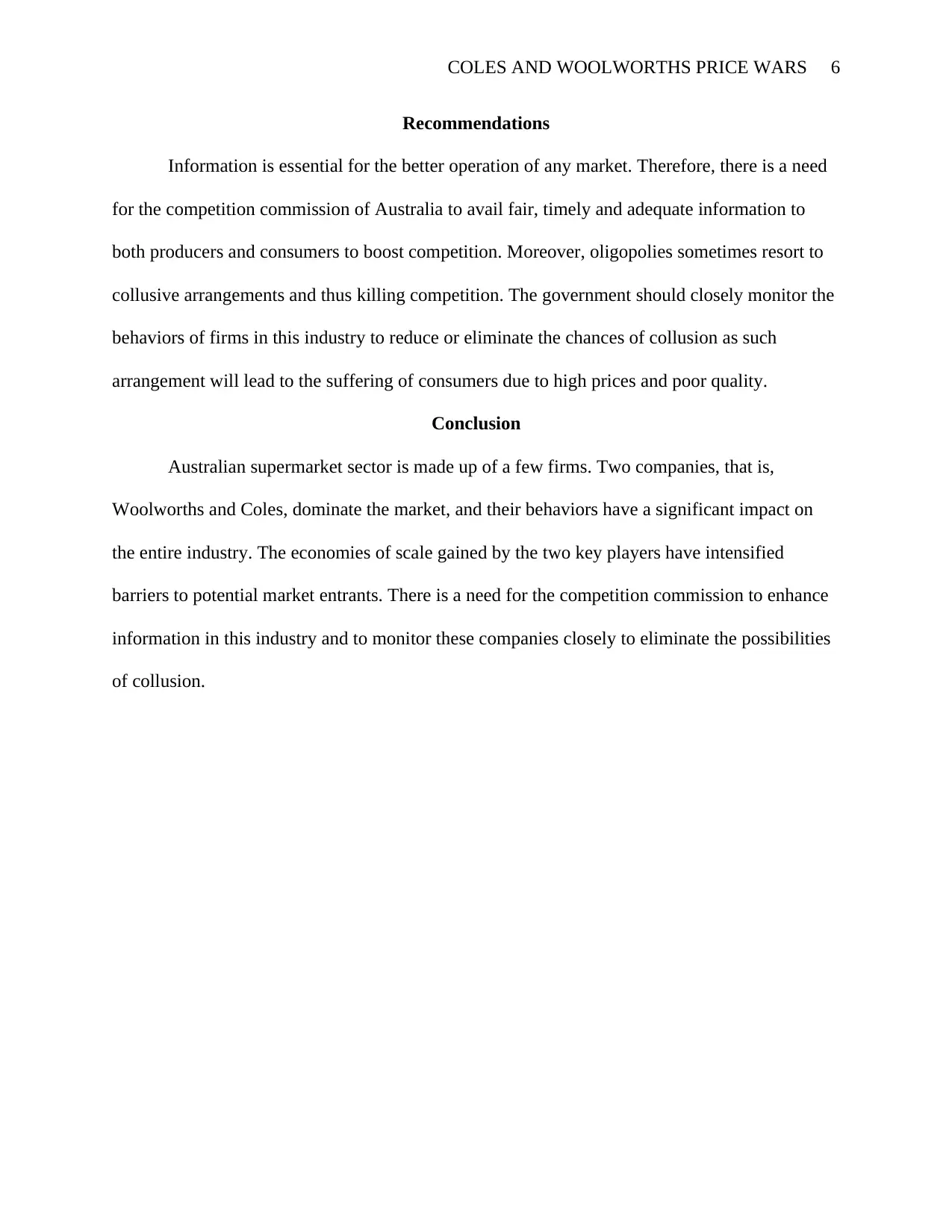
COLES AND WOOLWORTHS PRICE WARS 6
Recommendations
Information is essential for the better operation of any market. Therefore, there is a need
for the competition commission of Australia to avail fair, timely and adequate information to
both producers and consumers to boost competition. Moreover, oligopolies sometimes resort to
collusive arrangements and thus killing competition. The government should closely monitor the
behaviors of firms in this industry to reduce or eliminate the chances of collusion as such
arrangement will lead to the suffering of consumers due to high prices and poor quality.
Conclusion
Australian supermarket sector is made up of a few firms. Two companies, that is,
Woolworths and Coles, dominate the market, and their behaviors have a significant impact on
the entire industry. The economies of scale gained by the two key players have intensified
barriers to potential market entrants. There is a need for the competition commission to enhance
information in this industry and to monitor these companies closely to eliminate the possibilities
of collusion.
Recommendations
Information is essential for the better operation of any market. Therefore, there is a need
for the competition commission of Australia to avail fair, timely and adequate information to
both producers and consumers to boost competition. Moreover, oligopolies sometimes resort to
collusive arrangements and thus killing competition. The government should closely monitor the
behaviors of firms in this industry to reduce or eliminate the chances of collusion as such
arrangement will lead to the suffering of consumers due to high prices and poor quality.
Conclusion
Australian supermarket sector is made up of a few firms. Two companies, that is,
Woolworths and Coles, dominate the market, and their behaviors have a significant impact on
the entire industry. The economies of scale gained by the two key players have intensified
barriers to potential market entrants. There is a need for the competition commission to enhance
information in this industry and to monitor these companies closely to eliminate the possibilities
of collusion.
⊘ This is a preview!⊘
Do you want full access?
Subscribe today to unlock all pages.

Trusted by 1+ million students worldwide
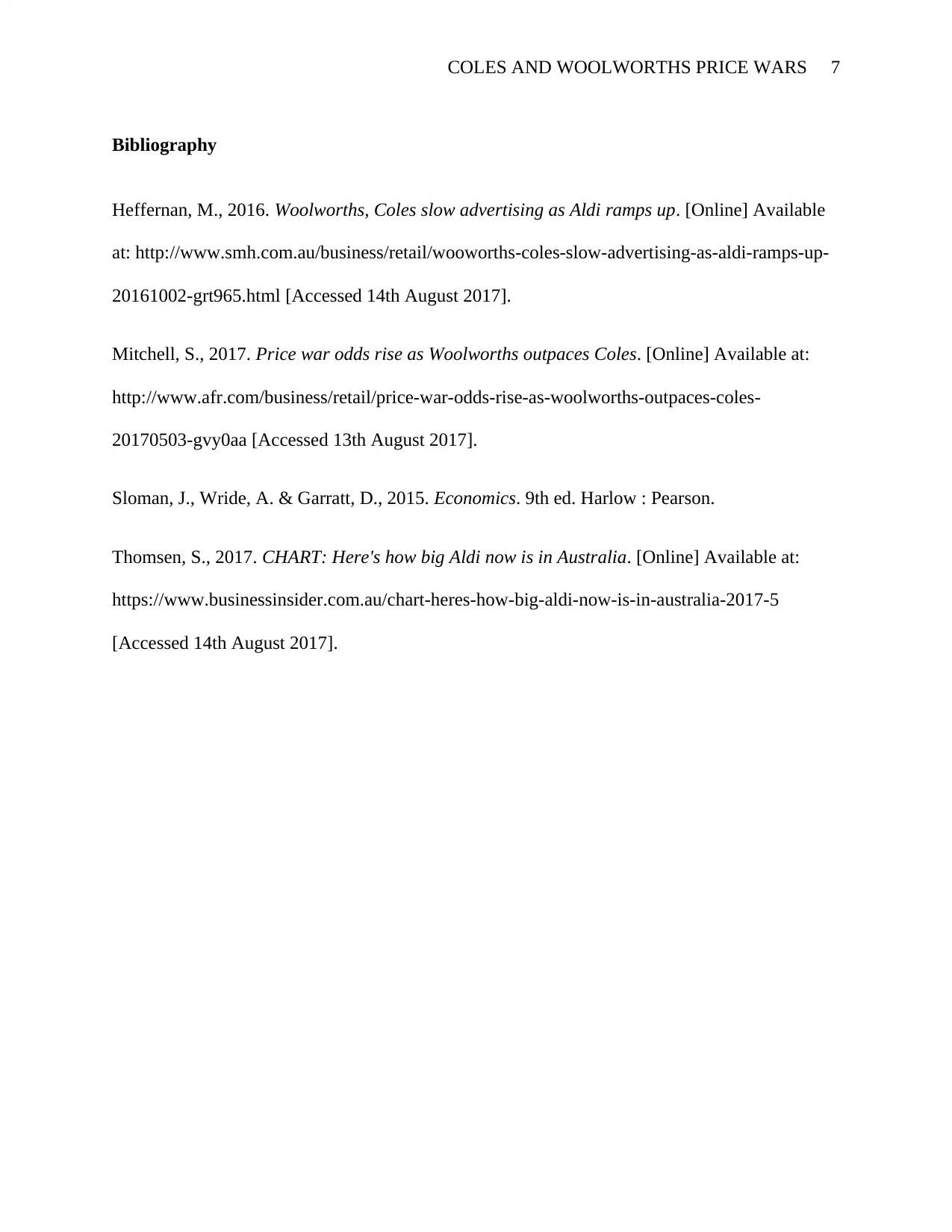
COLES AND WOOLWORTHS PRICE WARS 7
Bibliography
Heffernan, M., 2016. Woolworths, Coles slow advertising as Aldi ramps up. [Online] Available
at: http://www.smh.com.au/business/retail/wooworths-coles-slow-advertising-as-aldi-ramps-up-
20161002-grt965.html [Accessed 14th August 2017].
Mitchell, S., 2017. Price war odds rise as Woolworths outpaces Coles. [Online] Available at:
http://www.afr.com/business/retail/price-war-odds-rise-as-woolworths-outpaces-coles-
20170503-gvy0aa [Accessed 13th August 2017].
Sloman, J., Wride, A. & Garratt, D., 2015. Economics. 9th ed. Harlow : Pearson.
Thomsen, S., 2017. CHART: Here's how big Aldi now is in Australia. [Online] Available at:
https://www.businessinsider.com.au/chart-heres-how-big-aldi-now-is-in-australia-2017-5
[Accessed 14th August 2017].
Bibliography
Heffernan, M., 2016. Woolworths, Coles slow advertising as Aldi ramps up. [Online] Available
at: http://www.smh.com.au/business/retail/wooworths-coles-slow-advertising-as-aldi-ramps-up-
20161002-grt965.html [Accessed 14th August 2017].
Mitchell, S., 2017. Price war odds rise as Woolworths outpaces Coles. [Online] Available at:
http://www.afr.com/business/retail/price-war-odds-rise-as-woolworths-outpaces-coles-
20170503-gvy0aa [Accessed 13th August 2017].
Sloman, J., Wride, A. & Garratt, D., 2015. Economics. 9th ed. Harlow : Pearson.
Thomsen, S., 2017. CHART: Here's how big Aldi now is in Australia. [Online] Available at:
https://www.businessinsider.com.au/chart-heres-how-big-aldi-now-is-in-australia-2017-5
[Accessed 14th August 2017].
1 out of 7
Related Documents
Your All-in-One AI-Powered Toolkit for Academic Success.
+13062052269
info@desklib.com
Available 24*7 on WhatsApp / Email
![[object Object]](/_next/static/media/star-bottom.7253800d.svg)
Unlock your academic potential
Copyright © 2020–2025 A2Z Services. All Rights Reserved. Developed and managed by ZUCOL.





